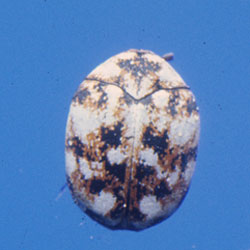Carpet beetles are in the family Dermestidae, which includes species that feed on several dry animal and plant products. Carpet beetles can damage fabrics, furnishings and clothing that contain natural animal fibers such as wool, silk, hair, bristles, fur or feathers. Synthetic items are resistant to attack, but mixtures of synthetic and natural fibers can be damaged. The natural habitats of carpet beetles are nests of birds, rodents, insects, and spiders. From these locations, they can spread into homes to damage carpets, rugs, and clothing. They also may feed on pollen and can be carried into the house on cut flowers.
The life cycle of carpet beetles can take from three months to two years. The adult female beetles lay up to 100 eggs, which hatch into larvae in one to two weeks. The larvae can develop under a wide range of temperature and humidity conditions. They tend to avoid light and actively feed in dark cracks, crevices, or folds. Most frequently they are found in the closets, drawers, or inside upholstered furniture. A larva requires from nine months to as much as three years to complete its growth, depending upon climatic conditions and food. The larvae wander considerably and may be found anywhere in a building. The presence of carpet beetle larvae can be detected by shed skin fragments and fecal pellets, which are about the size of a grain of salt, found around areas where they have been feeding. Adults are attracted to light and often are found on windows or around flowers.
The most damaging stage of carpet beetles is the larval stage. Because carpet beetle larvae can feed on dust and lint, good housekeeping can prevent infestations. Frequent cleaning of floors to remove dust and lint eliminates much of the available food supply, and some of the carpet beetles. However, regular cleaning will not remove dust and lint from air conditioning ducts and other inaccessible areas. Carpet beetles are among the most difficult indoor pests to control because of their ability to find food sources in obscure places, and they tend to disperse and cover large areas in a building.
Prevention Tips
Eliminate accumulations of lint, hair, dead insects, and other debris that serve as food for carpet beetles.
Regular and thorough cleaning of rugs, draperies, upholstered furniture, closets, and other locations where carpet beetles congregate is an important preventive and control technique.
Protect fabrics by keeping them clean; food and perspiration stains on fabrics attract carpet beetles.
Inspect stored woolens, linens, and furs, and air these items annually in the sun, brushing them thoroughly.

